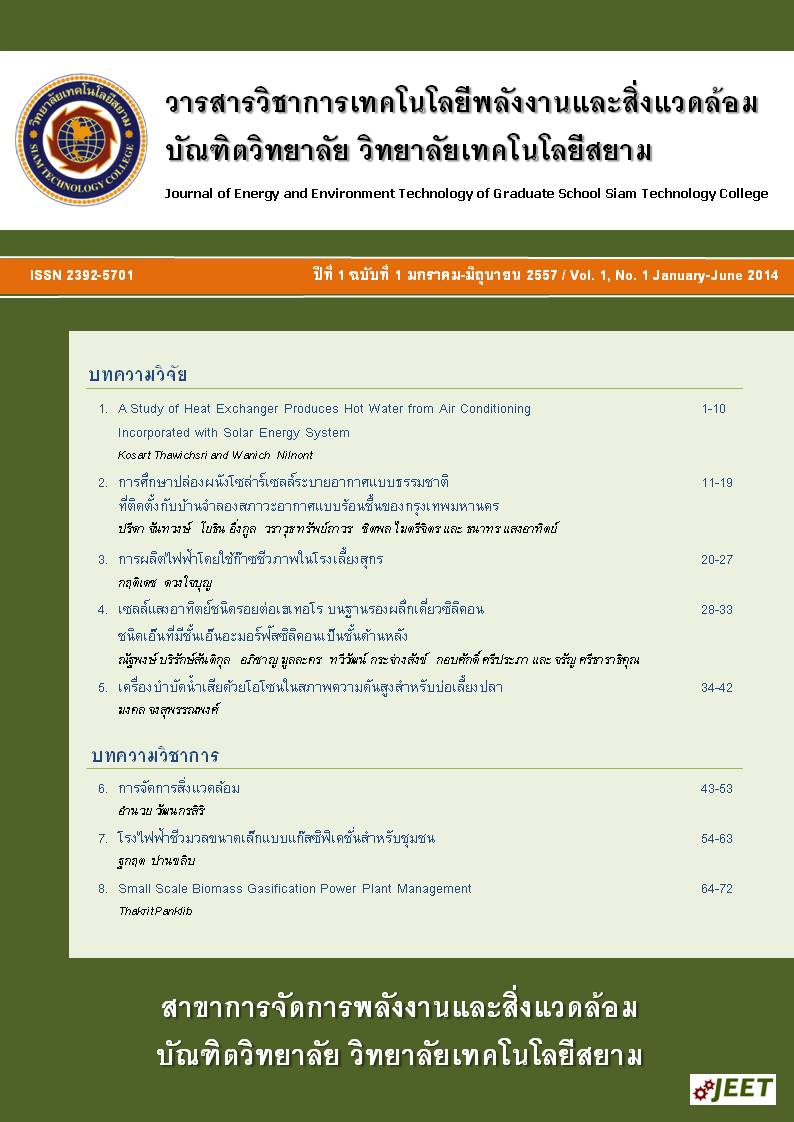Small Scale Biomass Gasification Power Plant Management
Main Article Content
Abstract
There are several agricultural residues in the country that can be used for biomass energy. At present, biomass is being used in the small electricity generation. It is an effective way to eliminate agricultural waste and simultaneously to reduce fossil fuel consumption. Recently, there are many incentives from the government for small and very small electricity producers. For examples, these electricity producers are allowed to sell the power to the grid under long term contracts, the government provides an “adder” on top of the normal tariff, assists in finding soft loans and investment subsidies, etc. With the aforementioned benefits, a prototype of small biomass gasification power plant of 200 kW capacities was installed at Prachinburi province of Thailand. The plant uses local agricultural residues such as corn cob, cassava, eucalyptus bark and chip wood as fuel. Total cost of electricity generated is estimated at 1.97 Baht/kWh. The electricity is then sold to the electricity authority of Thailand (EGAT) at 3.44 baht/kWh (in 2010). Thus, the power plant makes a profit of 1.48 baht for every kWh. If the plant is operated at 80% of its full capacity, the total electricity of 1,401,600 kWh will be generated per year. The annual profit of selling the electricity is amounted to 2,070,451 Baht. Impressively, at this profit, the payback period is approximately 5.8 years. Moreover, the small biomass gasification power plant does not only eliminate agricultural waste effectively in the surrounding area, but also reduces the customary process of the disposal by burning. The emission to the atmosphere is thus reduced. In addition, the plant creates jobs and income for local people.
Article Details
เนื้อหาและข่อมูลในบทความที่ลงตีพิมพ์ในวารสารวิชาการ เทคโนโลยี พลังงาน และสิ่งแวดล้อม บัณฑิตวิทยาลัย วิทยาลัยเทคโนโลยีสยาม ถือเป็นข้อคิดเห็นและความรับผิดชอบของผู้เขียนบทความโดยตรง ซึ่งกองบรรณาธิการวารสารไม่จำเป็นต้องเห็นด้วย หรือว่าร่วมรับผิดชอบใด ๆ
บทความ ข้อมูล เนื้อหา รูปภาพ ฯลฯ ที่ได้รับการตีพิมพ์ในวารสารวิชาการ เทคโนโลยี พลังงาน และสิ่งแวดล้อม บัณฑิตวิทยาลัย วิทยาลัยเทคโนโลยีสยาม ถือเป็นลิขสิทธิ์ของวารสารวิชาการ เทคโนโลยี พลังงาน และสิ่งแวดล้อม บัณฑิตวิทยาลัย วิทยาลัยเทคโนโลยีสยาม หากบุคคล หรือหน่วยงานใดต้องการนำทั้งหมด หรือส่วนหนึ่งส่วนใดไปเผยแพร่ต่อ หรือเพื่อกระทำการใด ๆ จะต้องได้รับอนุญาต เป็นลายลักษณ์อักษรจากวารสารวิชาการ เทคโนโลยี พลังงาน และสิ่งแวดล้อม บัณฑิตวิทยาลัย วิทยาลัยเทคโนโลยีสยาม เท่านั้น
References
[2] SC Bhattachaya, RM Shrestha, and S Ngam-kajurnvivat. Potential of biomass residue availability: the case of Thailand. Energy Sources. 1989; 11, 201-216.
[3] T. Panklib et al. Potential of biomass energy from agricultural residues for small electricity generation in Thailand. Energy Sources Part A. 2014; 36, 08, 803-814.
[4] AK Rajvanshi. Biomass Gasification Alternative Energy in Agriculture. CRC Press. 1986; 2, 83-102.
[5] RW Breault. Gasification Processes Old and New. A Basic Review of the Major Techno-logies Energies. 2010; 3, 216-240.
[6] EPPO. Thailand energy statics 2010. Energy Policy and Planning Office, Ministry of Energy, Thailand, Bangkok, 2010.
[7] EC-ASEAN Cogen Program. Evaluation of conditions for electricity production based on biomass. Bangkok, 1998.
[8] DEDE. Thailand Alternative Energy Situation 2008. Department of Energy Development and Promotion, Bangkok, 2008.
[9] TB Reed, and A Das. Handbook of Biomass Downdraft Gasifier Engine System, Golden CO: SERI. 1988.
[10] B Kjellström, H Stassen, and D Silva. Wood Gas as Engine Fuel, Food and Agriculture Organization of the United Nations (FAO),Via- delle Terme di Caracalla, Italy. 1986.
[11] L Yong. Introduction of Small-scale Biomass Gasification: Electricity Generation Systems, International Conference on Bioenergy Utiliza-tion and Environment Protection, China, 2003.
[12] ED Larson. Small-Scale Gasification-Based Biomass Power Generation, Center for Energy and Environmental Studies, Princeton University USA, Biomass Workshop, 1998.


